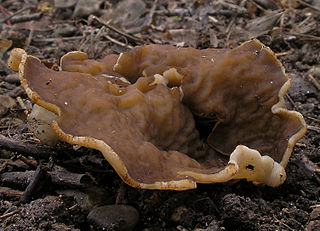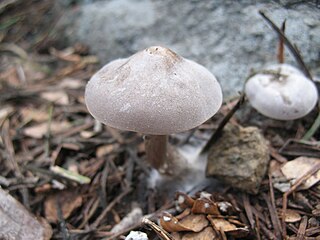
The International Union for Conservation of Nature (IUCN) Red List of Threatened Species, founded in 1964, is the world's most comprehensive inventory of the global conservation status of biological species. It uses a set of precise criteria to evaluate the extinction risk of thousands of species and subspecies. These criteria are relevant to all species and all regions of the world. With its strong scientific base, the IUCN Red List is recognized as the most authoritative guide to the status of biological diversity. A series of Regional Red Lists are produced by countries or organizations, which assess the risk of extinction to species within a political management unit.

Gyromitra is a genus of about 18 species of ascomycete fungi. They are a false morel - a frequently toxic mushroom that can be mistaken for edible mushrooms of the genus Morchella (morels).

Discina is a genus of ascomycete fungi related to the false morels of the genus Gyromitra. There are about 20 species in the genus. They bear dish- or cup-shaped fruit bodies. The best known member is the pig ear (D. perlata), which is deemed edible after thorough cooking, although is viewed with suspicion given its relation to the highly toxic false morels.

Gomphus clavatus, commonly known as pig's ears or the violet chanterelle, is an edible species of fungus in the genus Gomphus native to Eurasia and North America. The fruit body is vase- or fan-shaped with wavy edges to its rim, and grows up to 15–16 cm wide and 17 cm tall. The upper surface or cap is orangish-brown to lilac, while the lower spore-bearing surface, the hymenium, is covered in wrinkles and ridges rather than gills or pores, and is a distinctive purple color. Described by Jacob Christian Schäffer in 1774, G. clavatus has had several name changes and many alternative scientific names, having been classified in the genus Cantharellus, though it is not closely related to them.
In biology, a species is the basic unit of classification and a taxonomic rank of an organism, as well as a unit of biodiversity. A species is often defined as the largest group of organisms in which any two individuals of the appropriate sexes or mating types can produce fertile offspring, typically by sexual reproduction. Other ways of defining species include their karyotype, DNA sequence, morphology, behaviour or ecological niche. In addition, paleontologists use the concept of the chronospecies since fossil reproduction cannot be examined.

Disciotis venosa, commonly known as the bleach cup, veiny cup fungus, or the cup morel is a species of fungus in the family Morchellaceae. Fruiting in April and May, they are often difficult to locate because of their nondescript brown color. Found in North America and Europe, they appear to favor banks and slopes and sheltered sites. Although D. venosa is considered edible, it may resemble several other species of brown cup fungi of unknown edibility.

Galiella rufa, commonly known as the rubber cup, the rufous rubber cup, or the hairy rubber cup, is a species of fungus in the family Sarcosomataceae. The fungus produces cup-shaped fruit bodies that typically grow in clusters on branches and exposed portions of buried wood throughout eastern and Midwest North America and in Malaysia. The fruit bodies have the texture of tough, gelatinous rubber, and have a rough, blackish-brown, felt-like outer surface and a smooth reddish-brown inner surface. Although generally considered inedible by North American mushroom field guides, it is commonly consumed in Malaysia. The fungus produces several interesting natural products.

A snowbank fungus is any one of a number of diverse species of fungi that occur adjacent to or within melting snow. They are most commonly found in the mountains of western North America where a deep snowpack accumulates during the winter and slowly melts through the spring and summer, often shaded by coniferous forest. They may be saprotrophic, mycorrhizal, or in the case of Caloscypha fulgens, pathogenic.
Elachista discina is a moth of the family Elachistidae that is endemic to Australia.

Composita is an extinct brachiopod genus that lived from the Late Devonian to the Late Permian. Composita had a cosmopolitan global distribution, having lived on every continent except Antarctica. Composita had a smooth shell with a more or less distinct fold and sulcus and a round opening for the pedicle on the pedicle valve. Composita is included in the family Athyrididae and placed in the subfamily Spirigerellinae.
Discinida is an order of brachiopods comprising the extant superfamily Discinoidea, and the extinct superfamilies Botsfordioidea (early—mid-Cambrian) and Acrotheloidea. It represents a sister taxon to the Lingulids, and is possibly paraphyletic with respect to the Acrotretoids.—or the acrotretids are paraphyletic with respect to it. The group displays a broad range of shell structures, some of which incorporate substantial organic or silicified components.

Discina perlata, commonly known as pig's ears is a brown to tannish, wrinkled, cup- or ear-shaped fungus, sometimes with short, stout stalk. The spores of D. perlata are quite similar to those of mushrooms in the genus Gyromitra, so that some mycologists classify it there.







